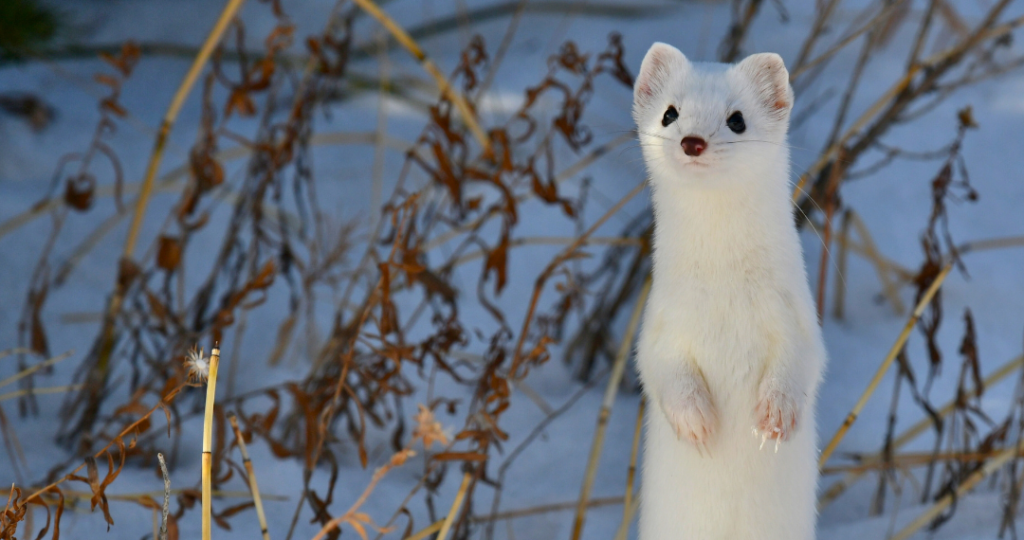Winter in the Greater Yellowstone Ecosystem poses significant challenges for its year-round residents. Food, especially for herbivores, can be is scarce, and the weather is harsh, with cold, windy, and unpredictable conditions. While it’s easier to see how large mammals like bison can survive these extremes, smaller creatures, like the Long-tailed Weasel and Short-tailed Weasel, also thrive in this environment.
Mammals are well-equipped for winter. They shed their coats in late spring, growing longer guard hairs to protect a dense underfur. This underfur, which thickens in the fall, traps air for warmth. Oil glands near each hair waterproof the coat. Additionally, mammals can control their fur, fluffing it for insulation or smoothing it to cool down. Mammals and waterfowl have another adaptation to cold weather: counter-current heat exchange in their limbs. When temperatures drop, for example when an animal stands in cold water, “surface blood vessels constrict, shunting blood into deeper veins that lie close to arteries. Cooled blood returning from extremities is warmed by arterial blood traveling towards the extremities, conserving heat.” (Yellowstone National Park).
Long- and Short-tailed Weasels go a step further by changing their coat color in the winter. In the summer, Short-tailed Weasels are light brown with a white underside, and Long-tailed Weasels are light brown with a yellowish rust-colored underside. As fall turns to winter, both species become all-white, aside from the ends of their tails, which remain black-tipped all year. This change in fur color provides both camouflage against the snow and additional insulation, as white hairs are actually hollow. Rather than containing pigment, these hairs contain air that can trap more heat and keep the weasels warmer. This adaptation can have consequences on winters like this one, when snow is slow to accumulate. The camouflage doesn’t work so well on brown vegetation. While it might be difficult to tell these 2 species apart, as their name suggests, Short-tailed Weasels are smaller. At around 8-13 inches long, they are shorter than the Long-tailed Weasel’s 13-18 inch total length. Males of both species are about 40% larger than their female counterparts.
Weasels, small and slender with minimal body fat, are well-suited for hunting rodents in burrows and dens. Despite their diminutive size, they remain active throughout the winter. Their resting metabolism is often double that of similarly sized animals, requiring them to consume more food daily than other winter-adapted species, as noted by Bernd Heinrich in Winter World: The Ingenuity of Animal Survival. Heinrich’s radio tracking studies reveal that weasels spend most of their winter days eating and resting. He writes: “Weasels need no permanent den, nor do they need a large stomach, because after reaching the rodent nest they use their victim’s nest for their own and curl up into a ball to conserve energy while feeding about 5 to 10 times per day. After finishing their meal and again in need of energy supplies, they sally forth on their next hunt.” (Yellowstone Forever)
So, the next time you’re bundled up in your warmest winter coat, spare a thought for the weasels of Yellowstone and Grand Teton National Park! Their ability to thrive in the harsh winter conditions is a testament to nature’s ingenuity. From their specialized fur to their relentless hunting habits, these creatures have adapted to survive and even flourish in one of the most extreme environments on Earth. Ready to experience the GYE in winter and learn more about the animals that call it home? Book a tour with Wildlife Expeditions to explore Yellowstone National Park in our custom designed Mercedes-Benz Snowcoaches, equipped with rooftop hatches for easier wildlife viewing access!
Sources:
2024 Yellowstone Resource and Issues Handbook
Yellowstone National Park – Winter Ecology
Yellowstone Forever – Small but Mighty: Yellowstone’s Weasels Survive Winter


